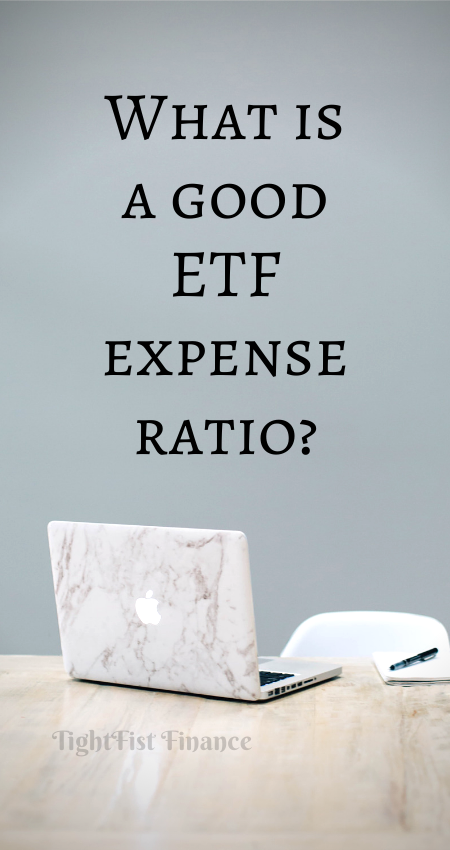What is a good ETF expense ratio?
A good ETF expense ratio is typically less than 0.5%. Typically, investors should stick with low-cost passively managed funds where performance historically beats actively managed funds. When comparing similar funds, the lower expense ratio can help you save money in fees.
Imagine, saving hundreds of thousands of dollars because you invested in a low-cost exchange traded fund. Sadly, new investors may fall into the trap of high expense ratios.
Luckily for you, I’m going to show you what you need to know about finding a good expense ratio. I will even show you a comment trap that new investors fall into. Use this information when you are shopping around for your next ETF.

This article may contain affiliate links which pays a commission and supports this blog. Thank you for your support!
What is a good ETF expense ratio?
A good ETF expense ratio is typically less than 0.5%. Actively managed funds cost more than passively managed funds. Most investors would be better off investing in a low-cost passively managed fund, like the S&P 500.
Actively managed funds have fairly high fees. It isn’t uncommon to see fees ranging from 0.5% to well over 1%.
Passively managed funds are usually low-cost. Typically, you can find great Investments with an expense ratio less than 0.2%.
Personally, I stick with low-cost Vanguard ETFs. A large portion of Vanguard’s ETFs have an expense ratio less than 0.1%.
Click to Tweet! Please Share!Click To TweetAre high expense ratios worth it?
High expense ratios are almost always not worth the additional cost. Most active fund managers charge high fees and still cannot beat passively managed funds like the S&P 500. In addition, you can find the same fund with varying expense ratios.
An active fund has a manager who is constantly buying and selling stocks trying to beat the market performance. Passively managed funds track an index like the S&P 500.
In general, active fund managers cannot beat a passively managed fund. Even if the fund manager outperforms the market one year, odds are small that they will repeat success. Therefore, long-term investing favors passively managed funds.
As you can imagine, it’s not worth paying a higher fee if the fund can’t consistently beat the market. Your money would be better off in a simple Index Fund like the S&P 500.
In addition, you can find the same funds with different expense ratios. The brokerage that offers the fund sets the expense ratio. Therefore, you can find an S&P 500 fund with a 0.03% expense ratio and another one for 1.2%.
The only difference is the brokerage who offers the fund. You are still buying the same stocks and assets, so why the expense difference?
How does expense ratio affect return?
You pay higher fees with higher expense ratios, which leads to smaller returns. There is less money in your investment account when you pay a higher expense ratio. Therefore, your investment growth is limited when you have less money in your investment account.
The best way to calculate the cost of your expense ratio is to use an expense ratio calculator. The calculator will allow you to see the full impact of fees over your investment timeline.
Let’s take a look at our example with the S&P 500. As I previously mentioned, you could find an S&P 500 Index Fund with a 0.03% and 1.2% expense ratios.
In our example, we will assume you are investing for 30 years starting from nothing. we will assume an 8% return on investment and contributing $5,000 per year.
At the end of 30 years, the 0.03% fund grows to 608k and you paid 3.5k in fees. However, the 1.2% fund grows to 486k and you paid 125k in fees!
As you can see, the high expense ratio consumed one quarter of your total portfolio value. The same higher-cost fund cost you an additional 121.5k in fees! That is an additional $121,500 you could have spent in retirement.
How do expense ratios get paid?
Expense ratios are automatically paid and taken out by your brokerage. Expense ratios are an annual fee against your total portfolio value. A portfolio of $100,000 at a 1% expense ratio would be charged $1,000 annually.
Click to Tweet! Please Share!Click To TweetSummary: What is a good ETF expense ratio?
As you can see, the lower the expense ratio the better your investment results will be. Typically, you should be looking to invest in an ETF with less than 0.5% expense ratio. However, passively managed funds can be found for less than 0.2%.
Usually, it is a good idea to avoid actively managed funds because they can’t outperform the market long term. In addition, actively managed funds are more costly. Essentially, you are investing for worse performance at a higher cost.
Be on the lookout for high cost ETFs. As an example, we looked at an S&P 500 Index Fund we’re different companies offer expense ratios of 0.03% and 1.2%. It’s the same product, but one cost more.
Over time, high expense ratios will eat away at your investment gains. Expense ratios are paid annually and you will probably not even notice they have been charged.
